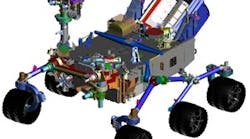Space exploration has once again captured the attention of many Americans, thanks to the successful launch of Space-X and Curiosity's Mars landing. NASA's car-sized Mars rover Curiosity blasted off from Cape Canaveral on November 26, 2011, and traveled millions of miles through space. On August 5, 2012, Curiosity went from the vacuum of outer space to the surface of the Red Planet in just seven minutes. Once on Mars, the Rover began its mission to move around the surface and explore for signs of life.
This video presentations shows you how Curiosity was designed, simulated and built before it was physically created. The presentation highlights the role Siemens Product Lifecycle Management (PLM) software played in helping engineers at NASA'S Jet Propulsion Labs (JPL) design the vehicle – from the initial concept to simulations of the harsh space environment.
The video also shows how PLM software is helping engineers create different device to go far and fast in an increasingly cost conscious environment. The latest spacecraft can go from 13,000 mph to 0 mph in seven minutes, withstand temperatures of -135 to 1500 degrees Celsius, and travel in orbit for 8 ½ months.
You can learn more by visiting Siemens




